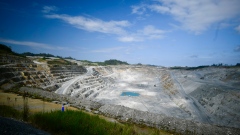Dec 12, 2023
Kim Jong Un Admits Rare Weakness as North Korea Population Falls
, Bloomberg News

(Bloomberg) -- Kim Jong Un’s rare admission that North Korea faces a population crisis indicates he’s just as worried about a demographic crunch that could undermine the economy as he is about the US forces that he says want to end his regime.
With little fuel, machinery or advanced technology, Kim needs a booming population to support the labor-intensive farm and industrial sectors, and fill the ranks of one of the world’s most militarized states. He told thousands of women last week at the first official gathering of mothers in over a decade that it’s their duty to produce more children to “stop the declining birth rate.”
“When all mothers clearly understand that it is patriotism to give birth to many children and do so positively, our cause of building a powerful socialist country can be hastened faster,” the official Korean Central News Agency reported him as saying.
Up until those comments, the only mentions of declining birthrates in major state media during his rule were about the demographic challenges in South Korea, which Pyongyang’s propaganda apparatus gleefully said were a reflection of “deplorable” problems in its capitalist neighbor.
South Korea is trying to address having the world’s lowest fertility rate — of just over 0.81 children over the lifetimes of women — through programs such as cash handouts to head off a crisis that threatens long-term economic prospects.
Kim has released no plans yet on what he might do.
When he wants to affect change, his government can plaster the country with posters, conduct massive “education” programs, saturate state media and chastise cadres at all levels for their failure to meet the government’s goals. Kim is set to hold a major policy-setting meeting at the end of this year, and if more mentions are made of a population decline, it could indicate it will be a focus in 2024.
“The loss of productive labor power will have substantial implications for the functioning of the North Korea economy,” said Peter Ward, a senior researcher at Kookmin University in Seoul, who has studied North Korea’s demographics.
Figures North Korea reported to the United Nations Population Fund show a fertility rate for women at 1.8 and a total population in 2023 of 26.2 million. This would indicate a population decline might start in about 2034, according to a research paper from the Hyundai Research Institute. If the actual numbers are lower, it could mean the day of reckoning is approaching more quickly.
The fertility rate was about 2.5 births per women in the early 1970s, according to a study of North Korea’s population published several decades ago by researchers Nicholas Eberstadt and Judith Banister for the University of California.
But Ward said studies of the current numbers indicate the figures from North Korea are implausible, with the fertility rate at perhaps 1.4 or 1.6 children per woman.
“They have ample incentive to exaggerate the size of their population because it helps with seeking aid from the outside world and it makes them look militarily stronger,” he said.
Ward said North Korea appears to have had two collapses in fertility, with the first being a major famine in the 1990s and the second coming after 2005, when reforms opened more doors for women to be a part of the active economy. This increased their independence, giving them more control over decisions with respect to family planning than in prior generations.
North Korea’s official data does little to reflect the damage caused by the famine that some estimates said killed more than 10% of the population over a number of years.
The period that North Korea refers to as the “Arduous March” triggered vast changes, with more women becoming the main economic agents for their families in markets set up at the time, according to a research paper for the Institute for Security & Development Policy by Kim Sung Kyung, an associate professor at the University of North Korean Studies in Seoul.
By 2016, more than 1 million entrepreneurs were in these markets, accounting for approximately 15% of the female population, the paper said. Married women avoided having children due to the economic burden, it said.
The Arduous March may have also affected the mindset of those who lived through it and are now of child-bearing age, said Kang Mi-jin, a North Korean defector who runs a company in South Korea that watches the economy of her former home.
“They may not want to have many children compared with their parents’ generation because they don’t want their children to experience the hardships with no food and no clothes that they went through,” she said.
Kim has refused to dismantle his nuclear program in return for easing sanctions that would allow his local industries to tap into global supplies for machinery and crucial materials. This likely means a labor-intensive economy will be the norm for a while as the US and its allies bolster their shows of force to deter Kim from ever using atomic weapons.
Kim has embellished his image as a father by having his preteen daughter accompany him at events including missile launches. This could be to show his people the nuclear weapons will be there to protect the next generation.
Kim and his daughter, thought to be about 10, donned sunglasses last month to visit airmen and see fighter jets, which underscored the message of military and family.
“When he appeared at the venue of photo session, all the service personnel raised cheers of excitement, looking up to the great brilliant commander, the tender-hearted father who always keeps the airmen nearest his mind and shows all sorts of love and privileges for them,” KCNA reported.
©2023 Bloomberg L.P.








